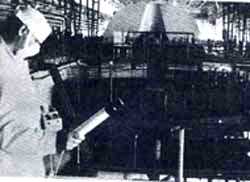Sudden jump in infant cancer cases
 THE INCIDENCE of thyroid cancer among children in the former Soviet republic of Belarus after the April 1986 Chernobyl nuclear accident has increased earlier than expected, placing a strain on the health services of the new country (Nature, Vol 359 No 6390).
THE INCIDENCE of thyroid cancer among children in the former Soviet republic of Belarus after the April 1986 Chernobyl nuclear accident has increased earlier than expected, placing a strain on the health services of the new country (Nature, Vol 359 No 6390).
In the areas most affected, the incidence of the cancer has risen from one case per million children under the age of 15 to some 80 children per million, say experts. In the first half of 1992, there were 30 cases of thyroid cancer and in 1991, there were 55 cases, compared to two children in 1986. One seven-year-old has died and ten are seriously ill, report doctors from Belarus.
Though external radiation to the neck leads to thyroid cancer, the increase in the disease among children within a few years of exposure to radioactive iodine was unexpected. Keith Baverstock, a radiation scientist with WHO's European Centre for Environment and Health in Rome and a member of a five-member WHO and Swiss government team that visited the area, said cancer of the thyroid usually occurs ten years after exposure to radiation. "The early appearance of the disease on this scale and its aggressive nature is unexpected... In Belarus, the increase in incidence was evident from 1990, four years after the accident."
The greatest increase was in the Gomel region -- from one or two cases per year to 38 in 1991. The area lies immediately to the north of Chernobyl and is known to have received a great deal of radioactivity as fallout after the breakdown of the nuclear reactor. The plume passed over Gomel in the first few hours and then over the Brest and Grodno regions, where there have also been increased incidence of thyroid cancers after 1990.
At the time of the Chernobyl accident, eight of the victims in Belarus were less than about three months of foetal age, a time when iodine starts to be taken up by the embryonic tissue.
